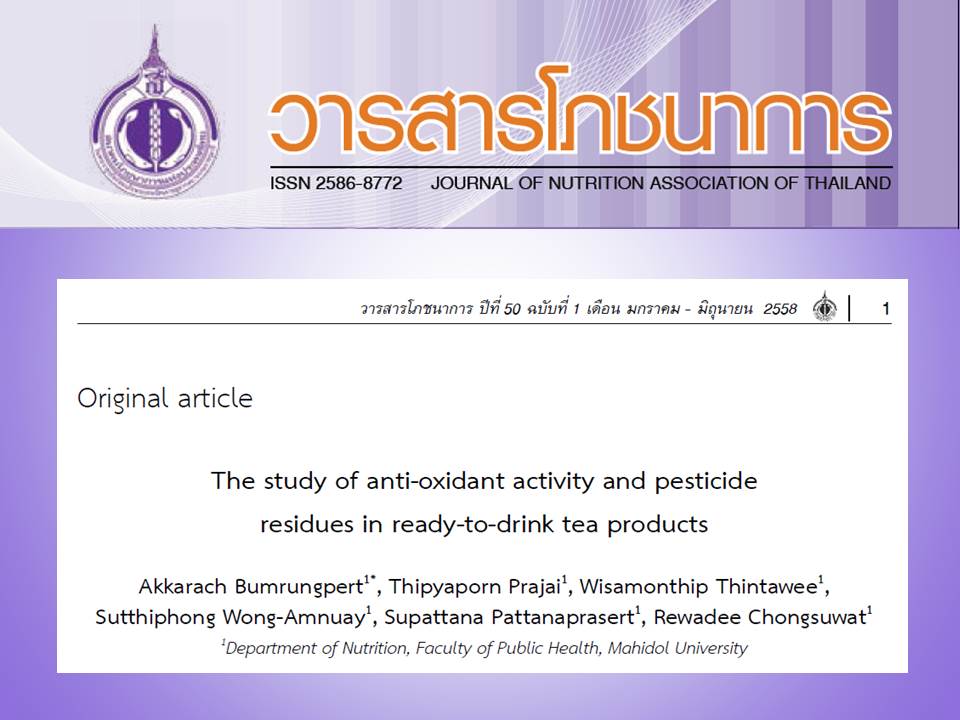The study of anti-oxidant activity and pesticide residues in ready-to-drink tea products
Abstract
The consumption of healthy beverages has been popular and there are wide varieties of choices. One of them is a ready-to-drink tea product. Tea is divided into four types that are based on the manufacturing process including green tea, black tea, oolong tea, and white tea. The major bioactive compound of tea is polyphenol (catechin) which has anti-oxidant and health promoting effects. However, food safety regarding pesticide residues in tea beverage should be a concerned issue. Therefore, the objectives of this study were to examine anti-oxidant activity and residues of pesticides in ready-to-drink tea products. The twenty samples (green, black, oolong, and white tea) were randomly selected based on popular brands and various flavors. The pesticide residues was analyzed by GT test kit and the anti-oxidant activity was examined by Oxygen Radical Absorbance Capacity (ORAC) and Ferric Reducing Anti-oxidant Power (FRAP) assay. The results found that four types of ready-to-drink tea products in the market still have anti-oxidant activity. The highest total anti-oxidant activity was green tea (9.99±0.16 mM TE/100 ml) followed by oolong tea (6.72±0.21 mM TE/100 ml), white tea (5.48±0.15 mM TE/100 ml), and black tea (5.05±0.15 mM TE/100 ml) respectively. Moreover, the result showed that some of green and black tea samples were contaminated by pesticide residues at a safe level but oolong and white tea were not contaminated. Therefore, the consumption of ready-to-drink tea products remains to benefit of anti-oxidants. However, consumers should be concerned about the amount of sugar, tannin and caffeine, as well as pesticide residues in tea.
References
2. Tenore CG, Stiuso P, Campiglia P, Novellino E. In vitro hypoglycaemic and hypolipidemic potential of white tea polyphenols. Food Chem. 2013;141:2379-84.
3. Basu A, Sanchez K, Leyva JM, Wu M, Betts MN, Aston EC, et al. Green tea supplementation affects body weight, lipids, and lipid peroxidation in obese subjects with metabolic syndrome. J Am Coll Nutr. 2010; 29(1):31-40.
4. Neyestani TR, Shariatzade N, Kalayi A, Gharavi A, Khalaji N, Dadkhah M, et al. Regular daily intake of black tea improves oxidative stress biomarkers and decrease serum C-reactive protein levels in type 2 diabetic patients. Ann Nutr Metab. 2010;57:40-9.
5. He RR, Chen L, Lin BH, Matsui Y, Yao XS, Kurihara H. Beneficial effects of oolong tea consumption on diet-induced overweight and obese subjects. Chin J Integr Med. 2009;15(1):34-41.
6. Cabrera C, Artacho R, Gime´nez R. Beneficial effects of green tea-a review. J Am Coll Nutr. 2006;25:79–99.
7. Bevenue A, Kawano Y. Green tea and DDT residue. Bull Environ Contam Toxicol. 1971;6(2):136-41.
8. Canadian Food Inspection Agency. Pesticide residues and metals in dried tea. Food Safety Action Plan REPORT 2009-2010. TS-CHEM. 2009/2010; 8.
9. เกสร นันทจิต, ลัดดา วงศ์พายัพกุล. การวิเคราะห์หาสารตกค้างของยาฆ่าแมลงในน้ำผัก, น้ำผลไม้และชาเขียวในภาชนะปิดสนิท. เชียงใหม่: คณะเภสัชศาสตร์ มหาวิทยาลัยเชียงใหม่; 2549.
10. กัลยวัจณ์ ธูปหอม, บุษย์ณิชนา ชนะพันธ์ภากร. ชุดน้ำยาตรวจสอบสารพิษตกค้าง/ยาฆ่าแมลง “GT” [อินเทอร์เน็ต]. 2547 [เข้าถึงเมื่อ 07 ม.ค. 2558]. เข้าถึงได้จาก: https://www.gttestkit.com/checking_gt.pdf.
11. Huang D, Ou B, Hampsch-Woodill M, Flanagan JA, Prior RL. High-throughput assay of oxygen radical absorbance capacity (ORAC) using a multichannel liquid handling system coupled with a microplate fluorescence reader in 96-well format. J Agric Food Chem. 2002;50(16):4437-44.
12. Ou B, Huang D, Hampsch-Woodill M, Flanagan JA, Deemer EK. Analysis of antioxidant activities of common vegetables employing oxygen radical absorbance capacity (ORAC) and ferric reducing antioxidant power (FRAP) assays: a comparative study. J Agric Food Chem. 2002;50(11):3122-8.
13. Huang Z, Li Y, Chen B, Yao S. Simultaneous determination of 102 pesticide residues in Chinese teas by gas chromatography–mass spectrometry. J Chromatogr. 2007;853:154–62.
14. Koirala P, Khadka DB, Dhakal S, Lama JP. Common tea pests and pesticides used in tea in Nepal. J Food Sci Technol. 2007;3:11-5.
15. เสรี หงษ์หยก, จริยา ผดุงพัฒนโนดม, ลอยชาย บุญปลื้ม. สารพิษในผักที่จำหน่ายในเขตจังหวัดนนทบุรี. การสารวิชาการสาธารณสุข. 2543;9(2):197-200.
16. Leopoldini M, Russo N, Toscano M. The molecular basis of working mechanism of natural polyphenolic antioxidants. Food Chem. 2011;125: 288–306.
17. Tewari S, Gupta V, Bhattacharya S. Comparative study of antioxidant potential of tea with and without additives. Indian J Physiol Pharmacol. 2000;44(2):215-9.
18. Benzie IFF, Szeto YT. Total antioxidant capacity of teas by the ferric reducing/antioxidant power assay. J Agric Food Chem. 1999;47(2):633–6.

Downloads
Published
How to Cite
Issue
Section
License
Upon acceptance of an article, copyright is belonging to the Nutrition Association of Thailand.


